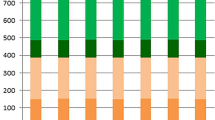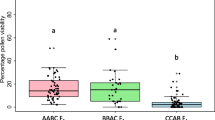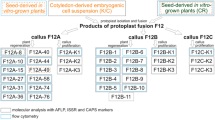Summary
Chromosome and organelle segregation after the somatic hybridization of related species with different degrees of genetic divergence were studied by comparing the interspecific somatic hybrids Brassica oleracea (CC) (+) B. campestris (AA), B. napus (AACC) (+) B. oleracea (CC) B. napus (AACC) (+) B. nigra (BB) and B. napus (AACC) (+) B. juncea (AABB) with the intergeneric somatic hybrids B. napus (AACC) (+) Raphanus sativus (RR) and B. napus (AACC) (+) Eruca sativa (EE). Within each combination, some hybrids were found whose DNA content was equal to the sum of parental chromosomes, others had a relatively higher DNA content and in most of the cases, some had a relatively lower content. However, the frequency distribution in these three classes differed significantly between the combinations. A positive correlation between the frequency of hybrids with eliminated chromosomes and the genetic distance between the species in each combination was found. Furthermore, by combining species with different ploidy levels we found a significantly higher degree of chromosome elimination compared to combinations of species with the same ploidy level. In the B. napus (+) B. Nigra, B. napus (+) R. sativus and B. napus (+) E. sativa combinations chromosomes from the B, R and E genomes appeared to be preferentially sorted out, as indicated by the fact that some of the nuclear markers from these genomes were missing in 7–46% of the plants, whereas no plants were lacking B. napus nuclear markers. Fertile hybrids were found in all but the B. napus (+) R. sativus fusion combination; the latter hybrids were male sterile, but female fertile. Hybrids between the A and C genomes were more fertile than hybrids obtained between the distantly related AC and B, R or E genomes, respectively. Analysis of the chloroplast RFLP pattern revealed that chloroplasts in the B. oleracea (+) B. campestris hybrids segregated randomly. A slightly biased segregation, favouring B. napus chloroplasts, was found in the B. napus (+) B. oleracea combination, whereas B. napus chloroplasts were strongly selected for in the B. napus (+) B. juncea, B. napus (+) B. nigra, B. napus (+) R. sativus and B. napus (+) E. sativa somatic hybrids.
Similar content being viewed by others
References
Bernatzky R, Tanksley SD (1986) Genetics of actin-related sequences in tomato. Theor Appl Genet 72:314–321
Bonnett HT, Glimelius K (1983) Somatic hybridization in Nicotiana: behaviour of organelles after fusion of protoplasts from male-fertile and male-sterile cultivars. Theor Appl Genet 65:213–217
Butterfass TH (1989) Nuclear control of plastid division. In: Boffey SA, Lloyd D (eds) Division and segregation of organelles. Society for experimental biology seminar series, vol 35. Cambridge, pp 21–38
Chatterjee G, Sikdar SR, Das S, Sen SK (1988) Intergeneric somatic hybrid production through protoplast fusion between Brassica juncea and Diplotaxis muralis. Theor Appl Genet 76:915–922
Chen K, Wildman SG, Smith HH (1977) Chloroplast DNA distribution in parasexual hybrids as shown by polypeptide composition of fraction I protein. Proc Natl Acad Sci USA 74:5109–5112
Dixon WJ, Massey FJ (1969) Introduction to statistical analysis. McGraw-Hill, New York
Ericsson M (1988) Seed storage proteins; studies on the structure, molecular genetics and intracellular localization of napin from Brassica napus. PhD thesis, Swedish University of Agricultural Sciences. Part V, pp 1–19
Fahleson J, Råhlén L, Glimelius K (1988a) Analysis of plants regenerated from protoplast fusion between Brassica napus and Eruca sativa. Theor Appl Genet 76:507–512
Fahleson J, Dixelius J, Sundberg E, Glimelius K (1988b) Correlation between flow cytometric determination of nuclear DNA content and chromosome number in somatic hybrids within Brassicaceae. Plant Cell Rep 7:74–77
Fluhr R, Aviv D, Edelman M, Galun E (1983) Cybrids containing mixed and sorted-out chloroplasts following interspecific somatic fusions in Nicotiana. Theor Appl Genet 65:286–294
Gleba YY, Hoffmann F (1980) “Arabidobrassica”: A novel plant obtained by protoplast fusion. Planta 149:112–117
Gleba YY, Shlumukov LR (1990) Selection of somatic hybrids. In: Dix PJ (ed) Plant cell line selection: procedures and applications. VCH, Weinheim, pp 257–286
Glimelius K (1984) High growth rate and regeneration capacity of hypocotyl protoplasts in some Brassicaceae. Physiol Plant 61:38–44
Glimelius K, Chen K, Bonnett HT (1981) Somatic hybridization in Nicotiana: Segregation of organellar traits among hybrid and cybrid plants. Planta 153:504–510
Gimelius K, Djupsjöbacka M, Fellner-Feldegg H (1986) Selection and enrichment of plant protoplast heterokaryons of Brassicaceae by flow sorting. Plant Sci 45:133–141
Gupta SB (1969) Duration of mitotic cycle and regulation of DNA replication in Nicotiana plumbaginifolia and a hybrid derivative of N. tabacum showing chromosome instability. Can J Genet Cytol 11:133–142
Kaltsikes PJ (1971) The mitotic cycle in an amphidiploid (Triticale) and its parental species. Can J Genet Cytol 13:656–662
Kameya T, Kanzaki H, Toki S, Abe T (1989) Transfer of radish (Raphanus sativus L.) chloroplasts into cabbage (Brassica oleracea L.) by protoplast fusion. Jpn J Genet 64:27–34
Klimaszewska K, Keller WA (1988) Regeneration and characterization of somatic hybrids between Brassica napus and Diplotaxis harra. Plant Sci 58:211–222
Landgren M, Glimelius K (1990) Analysis of chloroplast and mitochondrial segregation in three different combinations of somatic hybrids produced within Brassicaceae. Theor Appl Genet 80:776–784
Maliga P, Menczel L (1986) Chloroplast transfer and recombination through protoplast fusion. In: Vasil IK (ed) Cell culture and somatic cell genetics, vol III. Academic Press, Orlando, pp 601–612
Palmer JD, Shields CR, Cohen DB, Orton TJ (1983) Chloroplast DNA evolution and the origin of amphidiploid Brassica species. Theor Appl Genet 65:181–189
Possingham JV, Hashimoto H, Oross J (1989) Factors that influence plastid division in higher plants. In: Boffey SA, Lloyd D (eds) Division and segregation of organelles. Society for experimental biology seminar series, vol 35. Cambridge University Press, Cambridge, pp 21–38
Primard C, Vedel F, Mathieu C, Pelletier G, Chevre AM (1988) Interspecific somatic hybridization between Brassica napus and Brassica hirta (Sinapis alba L.). Theor Appl Genet 75:546–552
Robertson D, Palmer JD, Earle ED, Mutschler MA (1987) Analysis of organelle genomes in a somatic hybrid derived from cytoplasmic male-sterile Brassica oleracea and atrazine-resistant B. campestris. Theor Appl Genet 74:303–309
Rodin J, Ericson ML, Josefsson L-G, Rask L (1990) Characterization of a cDNA clone encoding a Brassica napus 12 S protein (cruciferin) subunit. J Biol Chem 265:2720–2723
Sambrook J, Maniatis T, Fritsch EF (1989) Molecular cloning, a laboratory manual. Cold Spring Harbor Laboratory Press, Cold Spring Harbor, N.Y.
Schenck HR, Röbbelen G (1982) Somatic hybrids by fusion of protoplasts from Brassica oleracea and B. campestris. Z Pflanzenzücht 89:278–288
Sikdar SR, Chatterjee G, Das S, Sen SK (1990) “Erussica”, the intergeneric fertile somatic hybrid developed through protoplast fusion between Eruca sativa Lam. and Brassica juncea (L.) Czern. Theor Appl Genet 79:561–567
Sjödin C, Glimelius K (1989a) Brassica naponigra, a somatic hybrid resistant to Phoma lingam. Theor Appl Genet 77:651–656
Sjödin C, Glimelius K (1989b) Transfer of resistance against Phoma lingam to Brassica napus by asymetric somatic hybridization combined with toxin selection. Theor Appl Genet 78:513–520
Song KM, Osborn TC, Williams PH (1988) Brassica taxonomy based on nuclear restriction fragment length polymorphisms (RFLPs) 1. Genome evolution of diploid and amphidiploid species. Theor Appl Genet 75:784–794
Song K, Osborn TC, Williams PH (1990) Brassica taxonomy based on nuclear restriction fragment length polymorphisms (RFLPs). 3. Genome relationship in Brassica and related genera and the origin of B. oleracea and B. rapa (syn. campestris). Theor Appl Genet 79:497–506
Stutz HC (1962) Asynchronous meiotic chromosome rythm as a cause of sterility in Triticale. Genetics 47:988
Sundberg E, Glimelius K (1986) A method for production of interspecific hybrids within Brassiceae via somatic hybridization, using resynthesis of Brassica napus as a model. Plant Sci 43:155–162
Sundberg E, Landgren M, Glimelius K (1987) Fertility and chromosome stability in Brassica napus resynthesised by protoplast fusion. Theor Appl Genet 75:96–104
Sundberg E, Lagercrantz U, Glimelius K (1991) The effect of cell type used for fusion on chromosome elimination and chloroplast segregation in Brassica oleracea (+) B. Napus hybrid plants. Plant Sci (in press)
Toriyama K, Hinata K, Kameya T (1987a) Production of somatic hybrid plants, “Brassicomoricandia” through protoplast fusion between Moricandia arvensis and Brassica oleracea. Plant Sci 48:123–128
Toriyama K, Kameya T, Hinata K (1987b) Selection of a universal hybridizer in Sinapis turgida Del. and regeneration of plantlets from somatic hybrids with Brassica species. Planta 170:308–313
UN (1935) Genome analysis in Brassica with special reference to the experimental formation of B. napus and peculiar mode of fertilization. Jap J Bot 7:389–452
Vamling K, Glimelius K (1990) Regeneration of plants from protoplasts of oilseed Brassica crops. In: Bajaj YPS (ed) Biotechnology in agriculture and forestry vol 10, Springer, Berlin Heidelberg New York, pp 385–417
Vindeløv LL, Christensen IJ, Nissen NI (1983) A detergent-trypsin method for the preparation of nuclei for flow cytometric DNA analysis. Cytometry 3:323–327
Author information
Authors and Affiliations
Additional information
Communicated by G. Wenzel
Rights and permissions
About this article
Cite this article
Sundberg, E., Glimelius, K. Effects of parental ploidy level and genetic divergence on chromosome elimination and chloroplast segregation in somatic hybrids within Brassicaceae . Theoret. Appl. Genetics 83, 81–88 (1991). https://doi.org/10.1007/BF00229229
Received:
Accepted:
Issue Date:
DOI: https://doi.org/10.1007/BF00229229




